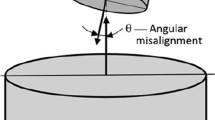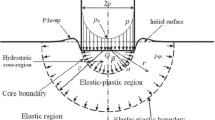Abstract
Nanoindentation is commonly used to determine the mechanical properties of the engineering materials. Young’s modulus of a bulk material can be extracted from the load–depth data obtained from an indentation test with a prescribed Poisson’s ratio that is unknown for a new material. The effect of Poisson’s ratio on material’s mechanical property characterization remains unknown. In this paper, finite element analysis was used to simulate nanoindentation testing on specimens of low-carbon steel AISI1018, steel alloy AISI4340, and aluminum alloy 6061T6 with a cylindrical flat-tip indenter. The effects of Poisson’s ratio on measurements of indentation load versus depth curves, Young’s modulus, hardness, and pile-up of the specimens were investigated and formulated. The Poisson ratio ranging from 0 to 0.49 was considered. It was found that the linear part at the beginning of the indentation loading process from the load versus depth curve was proportional to the Young’s modulus and significantly affected by the Poisson’s ratio. The indentation pile-up was also sensitive to the Poisson’s ratio. Combining the formulas from this work with the Hertzian contact equation, the Young’s modulus and the Poisson’s ratio can be determined simultaneously.






Similar content being viewed by others
References
American Society for Testing and Materials: ASTM E132-04(2010), Standard Test Method for Poisson’s Ratio at Room Temperature (ASMT International, West Conshohocken, Pennsylvania, 2010).
American Society for Testing and Materials: ASTM E111-04(2010), Standard Test Method for Young’s Modulus, Tangent Modulus, and Chord Modulus (ASMT International, West Conshohocken, Pennsylvania, 2010).
M. Doerner and W. Nix: A method for interpreting the data from depth sensing indentation instruments. J. Mater. Res. 1, 601 (1986).
W.C. Oliver and G.M. Pharr: An improved technique for determining hardness and elastic modulus using load and displacement sensing indentation experiments. J. Mater. Res. 7, 1564 (1992).
S.V. Hainsworth, H.W. Chandler, and T.F. Page: Analysis of nanoindentation load–displacement loading curves. J. Mater. Res. 11, 1987 (1996).
J.C. Hay, A. Bolshakov, and G.M. Pharr: A critical examination of the fundamental relations used in the analysis of nanoindentation data. J. Mater. Res. 14, 2296 (1999).
Z. Hu, K. Lynne, and F. Delfanian: Characterization of materials’ elasticity and yield strength through micro-/nano-indentation testing with a cylindrical flat-tip indenter. J. Mater. Res. 30, 578 (2015).
M. Bamber, K. Cooke, A. Mann, and B. Derby: Accurate determination of Young’s modulus and Poisson’s ratio of thin films by a combination of acoustic microscopy and nanoindentation. Thin Solid Films 398–399, 299 (2001).
J.F. Cárdenas-García and J. Rasty: The indentation test revisited: Obtaining Poisson’s ratio. In SEM X International Congress and Exposition on Experimental and Applied Mechanics Society for Experimental Mechanics, Inc., (Costa Mesa, California, 2004); p. 7.
I. Green: Poisson ratio effects and critical values in spherical and cylindrical Hertzian contacts. Int. J. Appl. Mech. Eng. 10, 451 (2005).
S. Liu and Q.J. Wang: Determination of Young’s modulus and Poisson’s ratio for coatings. Surf. Coat. Technol. 201, 6470 (2007).
B.B. Jung, S.H. Ko, H.K. Lee, and H.C. Park: Measurement of Young’s modulus and Poisson’s ratio of thin film by combination of bulge test and nano-indentation. Adv. Mater. Res. 33–37, 969 (2008).
B.B. Jung, H.K. Lee, and H.C. Park: Measurement of mechanical properties of thin films using a combination of the bulge test and nanoindentation. Trans. Korean Soc. Mech. Eng. B 36, 117 (2012).
Y.P. Zheng, A.P.C. Choi, H.Y. Ling, and Y.P. Huang: Simultaneous estimation of Poisson’s ratio and Young’s modulus using a single indentation: A finite element study. Meas. Sci. Technol. 20, 045706 (2009).
C.A. Clifford and M.P. Seah: Nanoindentation measurement of Young’s modulus for compliant layers on stiffer substrates including the effect of Poisson’s ratios. Nanotechnology 20, 145708 (2009).
J. Aw, H. Zhao, A. Norbury, L. Li, G. Rothwell, and J. Ren: Effects of Poisson’s ratio on the deformation of thin membrane structures under indentation. Phys. Status Solidi B 252, 1526 (2015).
E. Liu, G. Xiao, H. Wang, X. Yang, and X. Shu: Determination of the Poisson’s ratio of viscoelastic materials based on the linear rheological model using instrumented indentation. Soft Mater. 14, 38 (2015).
ANSYS Inc.: ANSYS theory reference manual. ANSYS version 18.1 (ANSYS Inc., Canonsburg, Pennsylvania, 2018).
Z. Hu, K.J. Lynne, S.P. Markondapatnaikuni, and F. Delfanian: Material elastic–plastic property characterization by nanoindentation testing coupled with computer modeling. Mater. Sci. Eng., A 587, 268 (2013).
Z. Hu, M. Farahikia, and F. Delfanian: Fiber bias effect on characterization of carbon fiber reinforced polymer composites by nanoindentation testing and modeling. J. Compos. Mater. 49, 3359 (2015).
Z. Hu, M. Shrestha, and Q. Fan: Nanomechanical characterization of porous anodic aluminum oxide films by nanoindentation. Thin Solid Films 598, 131 (2016).
N.B. Shahjahan and Z. Hu: Effects of angular misalignment on material property characterization by nanoindentation with a cylindrical flat-tip indenter. J. Mater. Res. 32, 1456 (2017).
Z. Hu: Chapter 6: Characterization of materials, nanomaterials, and thin films by nanoindentation. In Microscopy Methods in Nanomaterials Characterization, Vol. 1, S. Thomas, R. Thomas, A.K. Zachariah, and R.K. Mishra, eds. (Elsevier, Amsterdam, Netherlands, 2017); pp. 165–240.
Acknowledgments
This work was supported by the Materials Evaluation and Testing Lab (METLAB), the Department of Mechanical Engineering at South Dakota State University, and the State of South Dakota. Computational facility support from University High Performance Computing is gratefully acknowledged.
Author information
Authors and Affiliations
Corresponding author
Rights and permissions
About this article
Cite this article
Hu, Z., Hassan, M.M. Effect of Poisson’s ratio on material property characterization by nanoindentation with a cylindrical flat-tip indenter. Journal of Materials Research 34, 2482–2491 (2019). https://doi.org/10.1557/jmr.2019.160
Received:
Accepted:
Published:
Issue Date:
DOI: https://doi.org/10.1557/jmr.2019.160




